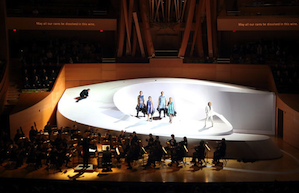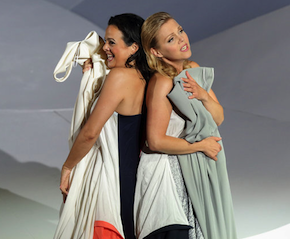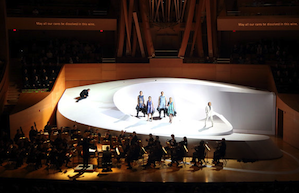
Photos by Craig T. Matthew
From the earliest days of his tenure as music director of the Los Angeles Philharmonic, Gustavo Dudamel expressed a desire to somehow transform the Walt Disney Concert Hall into the Walt Disney Opera House in order to present the Mozart/Da Ponte trilogy: The Marriage of Figaro, Don Giovanni, and Così fan tutte. No small task.
The first phase was realized in 2012 in a collaboration of talents that combined internationally recognized singers with superstar architects (turned set designers) with couture fashionistas creating the costumes; all three productions would be directed by Christopher Alden.
The first design team brought together the hall’s creator, Frank Gehry, with the clothing by the designer Rodarte. The production, though beautifully conducted and sung, had serious issues, including obstructed sightlines and a stage plan that placed the orchestra upstage of the singers which required Dudamel to conduct by means of strategically placed television monitors. He was not a happy camper.
The second collaboration matched a more open set by Jean Nouvel (that, on Dudamel’s insistence, moved the orchestra downstage) with Vogue-style costumes by Azzedine Alaïa.
Now we have Così, the most subtly handled production of the three, with a white curvilinear set by Zaha Hadid, that gracefully shifts like a sand dune in the wind, with pastel couture clothing by Hussein Chalayan that’s worthy of a Paris runway.
If in the trilogy of Mozart/Da Ponte operas The Marriage of Figaro represents a serious comedy about the sexual politics of class, and Don Giovanni explores the curse brought on by one man’s rapacious lust, then Così fan tutte stands as the gentle sister— a soft breeze of an opera about the sensual, heart-rending vicissitudes of love.
It’s clear that sensuality is the guiding principle behind this Così, from the seashell curvature of Hadid’s set and the elegant drapery of Chalayan’s contemporary costumes, to the double-cream rich textures of Dudamel’s conducting ... It's playful and charming and it works.
From start to finish it’s clear that sensuality is the guiding principle behind this Così, from the seashell curvature of Hadid’s set and the elegant drapery of Chalayan’s contemporary costumes, to the double-cream rich textures of Dudamel’s conducting.
Alden’s combination of literal and abstracted direction blends Mozartian grace and gentility with wit and comedic flair. Outbursts of volatile passion are balanced against abstract, character-revealing choreography and humorous interactions between the singers and the orchestra, particularly Dudamel, who, at one point, sings along and becomes a co-conspirator in the plot. It’s playful and charming and it works.
The full title Da Ponte gave to his 1790 opera was Così fan tutte ossia La scuola degli amanti (“Women are all the same" or "The School of Lovers”). Part comedy, part heart-felt drama, the action transpires from a wager, in which a mature man-of-the-world challenges a pair of head-strong young soldiers to test the fidelity of their intended brides. At first they are outraged by the proposition. But then they accept the bet anticipating new-found riches based on the perfect fidelity of their ladies fair. What transpires, however, is a round robin of disguised identities, manipulated episodes and partner swapping worthy of The Real Wives of Beverly Hills.

Rod Gilfry (who ironically created the part of Stanley Kowalski in Andre Previn’s 1998 opera A Streetcar Named Desire, which is currently on stage at the Dorothy Chandler Pavilion) brings a fascinating combination of emotions to the role of Don Alfonso, whose wager sets the plot in motion. He is a man clearly wounded in the battle of the sexes, who will be pleased to win his wager, but at the same time wishes his appraisal of female frailty might be proved wrong. Dressed simply in a back suit and pulled out white shirt, Gilfry is superb in the role. His resounding bass-baritone voice and air of superior skepticism provide the emotional anchor of the production. The idea that Don Alfonso is the conductor of the plot is taken quite literally as Gilfry interacts with and mimics Dudamel’s gestures. At one point he even sits in the audience and munches popcorn as machinations of his plan play out.
The two men of Ferrara (Ferrando and Guglielmo), who are convinced to masquerade as a pair of wild-and-crazy Albanians, are sung with macho bravado and genuine sensitivity by tenor Alek Shrader and baritone Philippe Sly. Their transformation from cocks-of-the-walk to chastened lovers is a joy to watch. Shrader’s Mozartian tenor lends itself perfectly to his characters sense of romantic anguish. Sly is the more robust and assured of the two, which makes his fiancée swap and decline into sorrow even more dramatic.
Their intendeds, Fiordiligi and Dorabella, are sung by the remarkable Swedish soprano Miah Persson and Romanian mezzo-soprano Roxana Constantinescu. Persson’s steadfast commitment to stand by her man, personified in her aria Come scoglio (“Like a rock”) makes the gradual cracking and crumbling of her resolve exceedingly poignant. Constantinescu, more like one of the characters in the HBO series, Girls, is willing to go whichever way the winds of passion blow. And Alden even admitted he’d been indulging in a marathon viewing of Girls and that its spirit had seeped into his direction.
The role of the wily servant Despina, who helps manipulate the action through a series of masquerades, is sung with charm and a tart edginess by Welsh mezzo, Rosemary Joshua. Joshua sings beautifully and looks fantastic in her perfectly cut Chalayan suits, even if her character would never in her wildest dreams be able to afford them.
To be perfectly honest, the Los Angeles Philharmonic has not always been the most reliable Mozart ensemble. It was a shortcoming that improved under the leadership of Esa-Pekka Salonen. But now, under the skilled baton and musical focus of Gustavo Dudamel the Philharmonic has attained a new level of elegance and clarity as a Mozart orchestra, making this Così a musical triumph and an operatic delight of the first magnitude.

